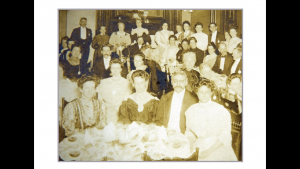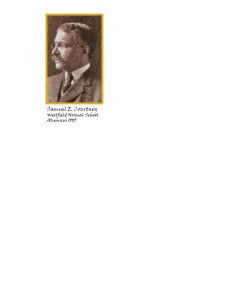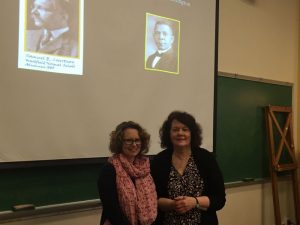
A photograph of Samuel Courtney, found by Holly Robbins and given to the Westfield State University Archives. This photo is being used with permission from the Westfield State University Archives, according to Robbins
WESTFIELD—A local woman is trying to bring attention to an obscure but influential person in American history, who also had ties to Westfield.
Westfield resident and former Westfield State University (WSU) employee Holly Robbins is telling the story of and trying to gain exposure for Samuel Courtney, an influential black American from the late 19th and early 20th centuries who worked with Booker T. Washington. Together, they helped to advance education and business for black Americans in the country and were friends for many years. Robbins has been giving presentations about Courtney, including one at Wheaton College in Norton, in hopes of garnering attention for the little-known historical figure.
Courtney’s name adorns a building at WSU, Courtney Residence Hall, which was built in 1989. Courtney, for a period of time was a resident of Westfield in addition to his name being put on a building, but until recently Robbins said that there was little known about his story. In fact, Robbins said WSU didn’t even have a photograph of Courtney.
 “The journey for me started when I was asked to write an abridged history of Westfield State University,” Robbins said. “I got to Samuel Courtney and there was no photo.”
“The journey for me started when I was asked to write an abridged history of Westfield State University,” Robbins said. “I got to Samuel Courtney and there was no photo.”
So, Robbins began to search for information on Courtney. And as she found more information, including letters written by Washington that mention Courtney, she couldn’t stop.
“Courtney chose me, I feel like he chose me,” she said. “I found his story and I could have just been vague, but I was so intrigued when I read the letters and saw the friendship. I couldn’t stop.”
According to Robbins, Courtney had a long history with Washington, which started as early as the mid- to late-1870s. Courtney was born into slavery in Malden, Virginia, in 1861, and it was in Malden that Washington first met Courtney, with the former being a teacher to the latter.
Washington, who began teaching black students in Malden in 1876 following his attendance at Hampton Institute in Hampton, Virginia, saw how bright Courtney was, Robbins said, and asked Courtney to also attend the Hampton Institute to further his education.
After graduation in 1879, Courtney came to Massachusetts for the first time, working as a servant for a family to help pay off his school debts. From there, he went back to Virginia to teach briefly, before coming back to Massachusetts.
In 1882, he arrived in Westfield, according to Robbins, and attended what was known as the Westfield Normal School until 1885. Normal schools were institutes that taught high school graduates how to be teachers. This was Courtney’s first exposure to Westfield, and although brief, was influential.
Upon graduating, Courtney went to work at Tuskegee Institute, the famous historically black university that was first established by Washington in 1881. At Tuskegee, Courtney taught mathematics and art, and also worked as a financial agent for the school for a year, traveling in the northern part of the country to try and gather money for the institute.
Courtney left Tuskegee in 1888, and continued pursuing education. According to Robbins, he was accepted into Harvard Medical School, and attended through the late 1880s and into the early 1890s, eventually graduating with a medical degree. Courtney then stayed in Boston, settling there but still working with Washington. While in Boston, Courtney contributed to the politics of the era, including being part of the Boston Riots of 1903 and being elected as the first black member to serve a full term in the Boston School Committee.
Meanwhile, Washington’s profile continued to grow and Courtney was there with him.
“Washington became the strongest black leader at the time, and Courtney was always by his side,” Robbins said.
It was during this time in Boston that Washington and Courtney also developed the National Negro Business League, which was formed in Courtney’s house in 1900. The group was formed to help black business owners prosper, and it still operates to this day but under a new name, the National Business League.
There’s more to Courtney’s story, and Robbins said that she is going to continue to tell it, as well as research to find out even more about his life.
“It’s been a wonderful journey,” Robbins said. “Never in my life did I think I was going to be writing about someone in history. And there’s still mysteries about him I need to solve.”
She added, “I feel that Courtney is hiding in plain sight, and this is the backstory.”


